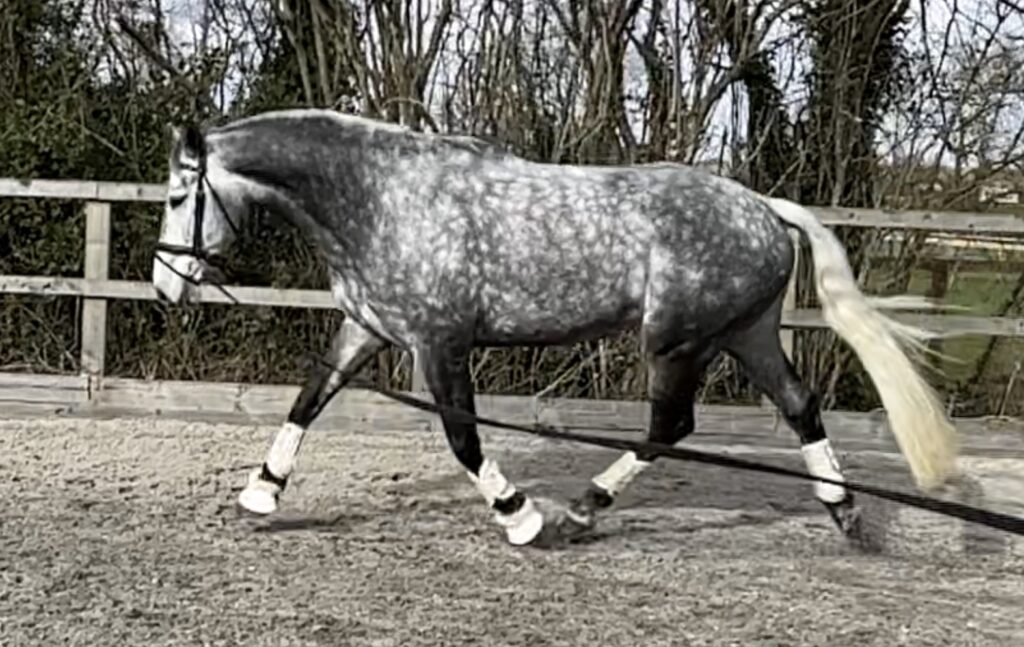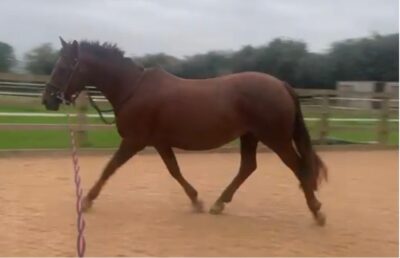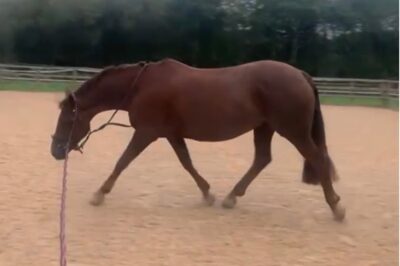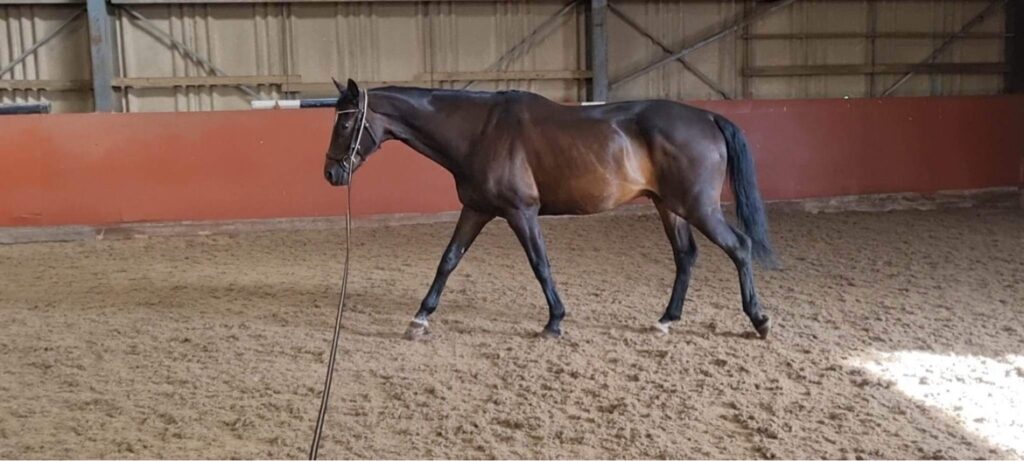Equipment, Performance & Fittening, Rehab, Training, Training and Management
Lunging horses
Veterinary Physiotherapist and Equine Coach, Chloe Mabbutt, discusses whether lunging horses should be part of a regular training programme
In recent years lunging horses has been criticised, with research highlighting how tight circles can exacerbate musculoskeletal dysfunctions¹ and, how it can cause a high arousal state so, being detrimental to the horse’s emotional training². However when performed well, lunging has many benefits that have been ‘forgotten’ but, there are a number of variables that influence whether lunging is appropriate such as:
- Arena size
- Age of horse
- Underlying conditions
- Owner/rider competence
- Tack specifics/preferences
…but for today, we are just going to discuss why you may want to consider utilising lunging in your training programme.

Positives and negatives of lunging horses
Pros of lunging
- Allows horse to move freely
- Allows continuous assessment of your horse’s movement
- Good for warming up a horse
- Useful for rehab/bringing back in to work when they cannot have a rider on
- Teaches horse self-carriage and bending
- Allows stretching of outside and strengthening of inside
- Teaches horse to yield to aids
- Can teach a horse about tack
- Useful if rider cannot ride due to injury etc
- Soft surface so limited concussion
- Can encourage relaxation and stretching
Cons of lunging
- Continuous small circles are bad for musculoskeletal health
- Can be unsafe if horse or rider not competent at the task
- f the horse is not capable of lunging due to injury, it can make it worse
- Usually only on soft surface, which may not be appropriate for that horse
- Can create bad habits/behaviours
Why might lunging be useful to include in your training programme?
As highlighted above, lunging isn’t all bad…in fact sometimes it is one of the most appropriate forms of exercise for your horse. For example if your horse has had kissing spine interspinous ligament surgery, it cannot yet take the weight of a rider but, needs consistent stretching through the back to ensure the ligaments do not heal contracted (always under a prescribed rehabilitation programme with your vet / veterinary physiotherapist). However, we aren’t talking about rehab…so, when can lunging horses be useful in a general training programme?
When performed well, lunging can help the horse learn self-carriage (Figure 1) and to bend through the thoracic region without the influence of a rider, as we aren’t all Grand Prix level riders! Additionally, it is an excellent tool to establish soundness. I always advise my clients to regularly watch and video their horses so if anything ever seems ‘off’ they have something to compare to. Circles add torsion through the body, with more weight on the inside limbs, and more stretching through the outside of the body³, so any issues can be exacerbated and easier to see than on the straight, or ‘felt’ under saddle.
Moreover, lunging can be more than just sending your horse round on a circle to get some energy out. It can be utilised to improve the horse-human bond when positive training techniques are incorporated, such as desensitisation techniques to equipment and, body cues as-well-as voice commands⁴. This is becoming more known as ‘groundwork’ and incorporates a range of techniques including lunging, where lunging is completed using a large oval shape compared to a tight circle, or even the entire arena, therefore you may need to get your running shoes on!
When is lunging not advisable – how do I know if it is right for my horse?
If you or your horse do not know how to lunge effectively – seek professional support to get you started on the right track. It is not as simple as just sending a horse out on to a circle and telling them when to trot and canter. It is also much more beneficial when it is performed with partnership – your horse understands yielding to voice aids and is calm and ‘in tune’ (Figure 2) when performed as mentioned above.

Additionally, some horses cannot cope mentally with a ‘traditional lunge session’ due to over arousal, which can become dangerous for both participants – a horse should not be galloping round on a circle just to get energy out. That is not effective and will simply increase their state of arousal also, these are the situations that incur damaging musculoskeletal pressures, as horses often then fall in on the circle adding further joint pressures and, reach speeds they are not capable of balancing – again increasing strain.
Basic handling needs to be established before lunging is incorporated, and a vet or veterinary physiotherapist ideally needs to have assessed your horse to ensure lunging is suitable for him. Then, once your horse responds to simple aids in hand, such as listening to body language to stop and start on cue and, has their ears and eyes focussed on you – not their surroundings, you are ready to lunge.

It has always been my personal opinion that horses that turn in to face you on the circle once they’ve been asked to stop are in tune and are not being disobedient. Turning in is different to walking in which can be dangerous. But either way, in order for it to be right for you and your horse, negative reinforcement should not be the only method of training (releasing of pressure when a command is met), horses respond to body more than voice, therefore allowing them to turn to face you in a calm manner is welcoming them to your herd and, has been shown to reduce the presence of stress behaviours⁴.
Additionally, the horse may be ready to learn to lunge, but not in tight circles, if they lean in rather than bend through their thoracic⁵, it shows inexperience and lack of balance, therefore bigger circles, going slower, and limiting time spent on the activity is key until they have built up strength. Lunging also is not advisable if the horse has conditions such as joint arthritis, due to the extra strain; this is why a musculoskeletal check is highly beneficial before beginning training, to ensure the horse is capable.
The basics of how to lunge
To start lunging a horse in theory you simply need something to secure their head such as a bridle or lunge cavesson, a lunge line, and ideally a lunge ‘whip’. Lunging tack is of hot debate and preference, and therefore will be expanded on in further articles but, a headcollar is not advisable brcause it can cause rope burns due to lack of padding and, they are often too loose fitting, so can move round to the incorrect place on the face – such as the eye! Many people also feel putting boots on their horse is better to prevent brushing injuries but, when lunging to check soundness they can visually impact movement and best not worn.
Every horse is an individual, for example my own horse used to hate nose pressure, so a lunge cavesson was not accepted, but a bridle a good choice. Others are too sensitive in the mouth to be lunged from a bridle, and therefore a lunge cavesson is better. This is something to discuss more with a trainer or behaviourist and links to the aims of your lunge, such as are you wanting to desensitise the horse to tack like a bridle or, wanting to teach self-carriage and not to lean on a bit? I would never advise the use of a bridle to try to ‘control’ a strong horse lunging; in-hand groundwork working on communication and bond should be employed in that case, NOT brute strength.
Long gone are the days where we advise standing in the centre of a 15-20m circle to lunge – oval/arena lunging is more preferable…therefore, you need to move! This is where line control and balance are key and takes practice. You do not need to spend 20 minutes with your horse trotting and cantering round for an effective lunge. More time in walk with transitions into different gaits, working on connection of voice and body aids and, getting the horse to learn to yield to these aids to increase suppleness, is time much better spent.

One piece of kit that is given a bad name but, I do often advise its use, is a lunge whip. However, it should NOT be use as a tool for punishment. When used correctly it should simply be an extension of your arm to guide the horse around the arena and create a nice safety length between you and the horse. If you have to ‘crack’ the whip to encourage movement…go back to the in-hand basics. Consider the whip a guiding hand, and you and your horse will have a much better relationship with it. I want my horses to yield away from it to know when to make the circle bigger, to know when to speed up and slow down but, to understand it will never be used for punishment should things not go to plan. If you cannot hold the whip near to your horse when leading them without them shying away, they need to be desensitised to it.
Once you have your chosen horse’s equipment; your own personal protective gear (such as hat, boots, gloves…safety first!); and have a suitable place to lunge, such as arena or well-kept grass area; and your horse is competent with your aids in-hand…you are good to start!
Having an aim for your training session is key and, working with professionals to ensure your horse is physically capable of that aim is vital. Every horse is an individual, therefore try different aids and assess that they are having the desired effective before settling on their use. It should be used as part of a holistic programme of training, with the horse always calm and ‘in tune’, if your horse is ‘fresh’, perform basic groundwork techniques such as in-hand walking adding stop and start cues, turns yielding to pressure, walking over poles etc, to engage the brain – do not swing them around on a circle this will only fry it! When carried out correctly far from a detrimental training technique, lunging has it’s place when carried out with horse welfare in mind and, not just seen as a release of energy.
In future articles the different variables will be discussed such as tack options, impact of surfaces, circle sizes, etc, and how to recognise your horse is lunging ‘correctly’.
For more information on whether you should use a training aid follow the links to;
should I use a training aid cotton lunge aid pessoa resistance bands
Win With Woof Wear!
Win this handy Telescopic Lunge Whip worth £40
Woof Wear’s Telescopic Lunge Whip has been designed to take the stress out of lunging. The handle is ergonomically designed to allow a comfortable and secure grip, the whip is nicely balanced so you can focus on your horse.The flexible fibreglass shaft is housed within a semi-rigid fibreglass outer- one quick pull and the whip is extended, ready for use.
Easy to store and transport with the collapsed length 95cm – fully extended 180cm
Enter to win here
References
- Pfau, T., et al. 2014. Lungeing on hard and soft surfaces: Movement symmetry of trotting horses considered sound by their owners. Equine Veterinary Journal; 48(1): https://doi.org/10.1111/evj.12374
- Fenner, K., et al. 2019. Cutting to the chase: How round-pen, lunging, and high-speed liberty work may compromise horse welfare. Journal of Veterinary Behavior; 29: https://doi.org/10.1016/j.jveb.2018.05.003
- Greve, L., and Dyson, S., 2018. What can we learn from visual and objective assessment of non-lame and lame horses in straight lines, on the lunge and ridden? Equine Veterinary Education; 32(9): https://doi.org/10.1111/eve.13016
- Fureix, C., et al. 2009. A preliminary study of the effects of handling type on horses’ emotional reactivity and the human–horse relationship. Behavioural Processes; 82(2): https://doi.org/10.1016/j.beproc.2009.06.012
- Greve, L., and Dyson, S., 2016. Body lean angle in sound dressage horses in-hand, on the lunge and ridden. Equine Veterinary Journal

